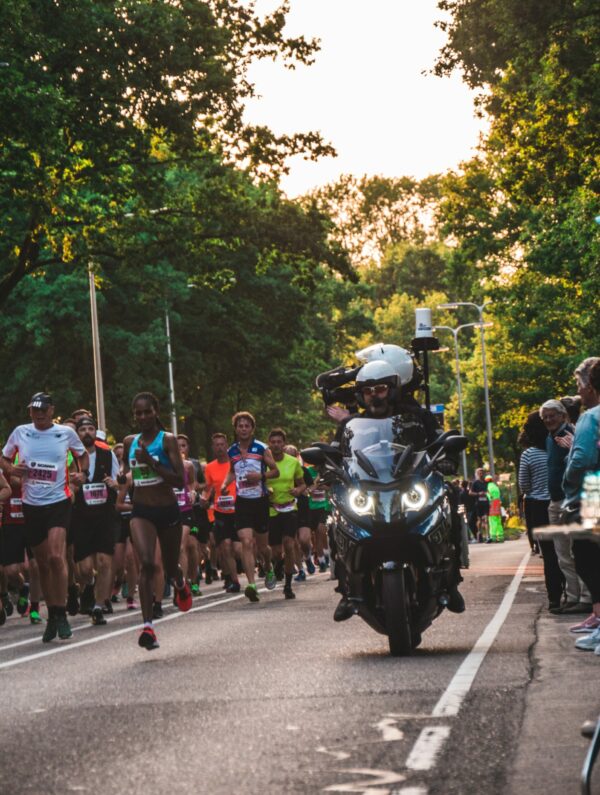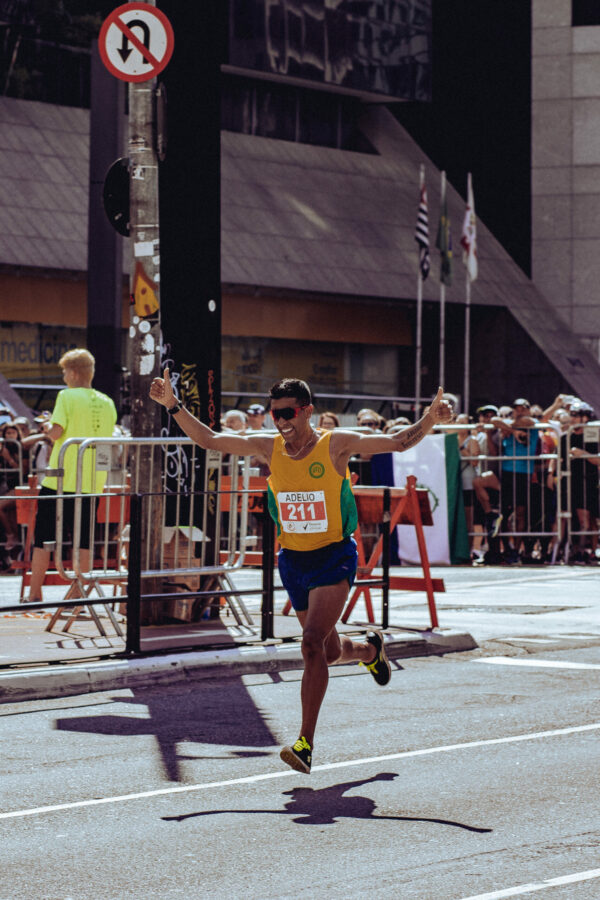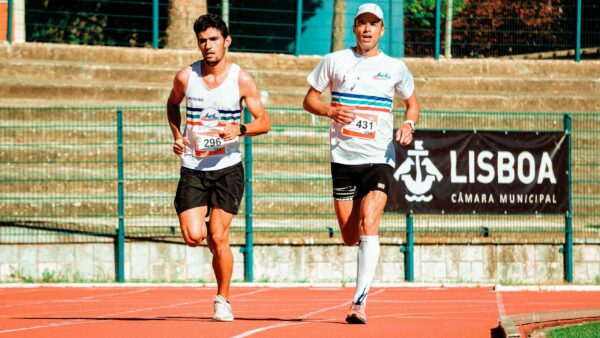If you want to cut off the learning curve and go directly to the best strategy in marathon training, you should build up the training around the 3 best ways to make marathon training a success. It’s a strategy that also considers our daily time factor. Maybe we say I don’t have the time to start up a marathon training program. But it doesn’t have to be that way.

Marathon Training methods
Your best strategy is to make your personal program with 3 key sessions per week. A training session with high-intensity training – also called VO2 max. as maximum oxygen uptake – a session with tempo run and a session with easy/moderate run as LSD. Every key session impacts the whole body in general and your running economy. They also have a main purpose, so they complement each other.
How to balance them to, how much you prefer using more of one of them compared to another in an optimal training week, will depend on what you wish from – philosophy, temper and personality. If you have less time for your weekly training, it’s best to use more of the high-intensity training compared to the other two. High-intensity training is the training method that gives the most effect per minute.
If you, on the other hand, have more time, you can add a recovery run as supplemental training.
Marathon Training categories
Wouldn’t it be great if you know, why you perform the different training types, what to do, when to do it and what you get out of the training combination concerning your goal?
Depending on the purpose of the training, there are many different training methods, which can be put together in a lot of different ways. The different training methods can also be grouped into categories.
If we look at the research in training physiology, particular 5 categories stand out, which are of great importance for performance at distances from 3 km up to marathon races. Four of them have a direct influence on the performance, while the fifth category, recovery training ensures that the body gets enough rest to benefit from the training in the other four categories.
The 5 different training categories:
-
Endurance
-
High-intensity training (VO2 Max.)
-
Lactate Threshold training (LT – training)
-
Strides
-
Recovery/Restitution training
Let’s take a closer look at the categories
Endurance training

Endurance is the most important factor in long-distance running also called LSD (Long Slow Distance). The ability to run at a high speed is irrelevant if you cannot keep pace all the way to the finish line. If you want to run a marathon, endurance is most important. In basic, endurance improves by gradually increasing the running distance over time.
This training category is about moving the limit of how far you can run, whereas the speed you run at, is not the most important. It doesn’t mean that the speed is irrelevant, you cannot run too slow, since the body needs a certain stimulus to create progress (adaptation) nor too fast, as it will be very stressful for the body.
Improvement of endurance
Improvement of Endurance is about running long distances at an easy/moderate pace, and you can use a heart rate monitor to manage the pace by running about 60 – 70 % of your max., which is the LSD training zone for beginners/intermediate runners. The heart rate monitor will make you aware if you run below 60% or higher than 70%. In other words, the Intensity when you run endurance training should be in “talking pace”. To find your talking pace you can also use the Borg scale.
In a training program, such as a marathon training program where you have to run a lot of kilometers, you should consider a pace that is slower than your planned marathon pace, so the body can keep up with the amount of training. If it’s too bothering running the long LSD runs, you can use music with earplugs or over-ear headphones It’s an excellent opportunity.
High-intensity training (VO2) max.

The maximum oxygen uptake is about how good the body is to produce energy using oxygen (aerobic energy). The maximum oxygen uptake corresponds to the maximum amount of oxygen that the body’s tissues, including the muscles, can absorb from the blood.
A very effective way to improve the maximum oxygen uptake (VO2) is through training that has an intensity very close to the current maximum oxygen uptake, which means training with a heart rate of around 95 – 98% of the max. heart rate. The body can only handle a limited amount of training, with such a high intensity. The training is therefore, best performed as intervals, hill training or tempo run.
This form of training is important for all types of runners, regardless of the distance you train to complete. But as a beginner, it’s too demanding and the risk of injuries is high.
Lactate Threshold training (LT – training)
Endurance training is about running far in a long time. With lactate threshold training, you will be able to run faster on the long distance. Lactate threshold (LT) describes the time or intensity at which the body no longer can get rid of lactate as quickly as it is formed. This means, it accumulates in the working muscles – your legs and you experience it as a burning sensation.
We can find (LT) based on practical tests in a laboratory, where blood samples are taken during physical activity on a treadmill and thus very precisely find the intensity at which LT begins to accumulate in the muscles. In this way, we can measure the heart rate and the speed you run at LT. In practice as runners, we use a heart rate monitor or the Borg scale.
Improvement of lactate threshold training

LT – Training is the most important form of training for long-distance runners, who want to improve their performance. The longer distances you run, the more important is this form of training for your performance. To move LT, the training must be completed with an intensity around LT. LT training should feel like a hard but comfortable pace.
LT – training is a hard form of training with high quality. It means, that there is a need for a longer recovery time after the training session. LT – training should therefore not be trained more than once a week particularly by marathon training, as the long LSD run also requires more recovery.
Lactate Threshold Training Types
Tempo Run
Is the classic form of training to move the LT – threshold. Tempo run is performed with 20 – 40-minute runs with an intensity corresponding to the LT – threshold or slightly below. A tempo run training session is often performed with about 3 kilometers of warm-up running followed by a 5 – 8 km Tempo run at a pace around LT and ends with 2 km of jogging. It is a hard training session that also provides a mental toughness that makes it easier to cope with hard training sessions and competitions.
Intervals
A cousin to Tempo run is intervals, where you can divide the load into intervals of 4 – 8 minutes duration. For example, if you perform 4 LT – intervals of 8 minutes duration with a 3 -4 minutes break between each, you achieve 32 minutes with the desired intensity. LT – intervals are a good alternative to fast pace.
Hill training
Long hills also provide good LT training. The training is similar to intervals, as you also use intervals here, you just run in hills of around 1000 m – 1500 m. You obtain good muscle strength, coordination, flexibility, better running economy and variation by Hill training.
Strides
Strides are your maximum speed when performing short sprints on 50 m – 150 m with everything you have. Strides are one of the 4 categories of training that is least important for long-distance runners. The shorter the distance, the greater the importance of strides. The significance is the biggest in the last 200 m, where you can over-sprint the competitors.
The purpose of strides as a long-distance runner and particular as beginners/intermediate is to avoid being too slow and one-sided and create some variation in the training. But it also strengthens the running style and muscle coordination and by using strides in the training, you will often be aware, that the other training sessions will be more effortless and comfortable.
Recovery/Restitution training

This kind of training is very gentle. It’s like jogging where the heart rate is about 50 – 60 % of max. heart rate. We run recovery runs on days after intensity runs as LT training, (VO2) max. training or a long LSD at a moderate pace. We also run recovery run, as start-up again after an injury.
A completely easy run stimulates blood circulation and hereby brings waste products away from the cells and nutrition into the cells more effectively than no activity at all. Recovery runs are only relevant for experienced runners, who are faster to recover and get ready again than beginners, who should take a break with no activity.
A Training Program
A training program can be build-up based on these 5 categories as basic principles. The structure and composition should take into account whether you are beginner, intermediate- or experienced runner, just as the goal of the training should be clearly formulated. A runner who trains to complete just óne 15k run should train differently than a runner who trains energetic to improve an already good time on 5k.
Final Thoughts
This post reveals all the main training methods from 3k to a marathon, that runners use today in one form or another. You can create a great variation from them.
As we have different fitness levels, running skills and experience in the starting point, it will be up to you, how you will put together a Frame/training program that fits your running purpose.
Are you interested in marathon training, I hope you like this review and if you have any questions about the topic or want to leave your own Personal review, please leave a comment below.
[faq-schema id=”2218″]






Marathon is something in what l am really passionate about during all my life. Waking up in the morning and going on joging is the first thing what l did for many years, but now l have a baby and cannot find enough time for training. Jogging is so important for mental and physical health and most people shoud think about joining it. Afer good training in the morning, whole day could be different.
Hi Trudnocairoditeljstvo
Thank you for the comment.
I can relate 100% to your words about Running here. It’s still something you have done before.
So you know how to begin again whenever you want.
Be Well
I mean it when I say it. This was extremely insightful. I had no idea there was so much to marathon training. I kind of assumed it’s just about straight-up running every day and maybe some weight lifting every other week. But clearly it’s a bit more complicated than that. I mean, before my understanding of the process was incredibly primitive, haha.
That being said, I loved the idea of adding strides in. They really seem like an unnecessary luxury when it comes to long-distance runners. However, I’m far too familiar with what boredom can do to the training efforts. And hence, I 100% subscribe to the necessity for variation, to make the whole endeavor less boring. I had no idea about the gains to the running cycle and muscle coordination. But that’s just something that makes the entire stride thing that much more important.
Thank you. 🙂
Hi Matiss
Thank you for the comment.
Yes, making strides in a long distance program is very vividly and uplifting
particular after running the longer LSD. It also preventing injuries in a marathon training program,
because you recruit other muscle groups.
Be Well